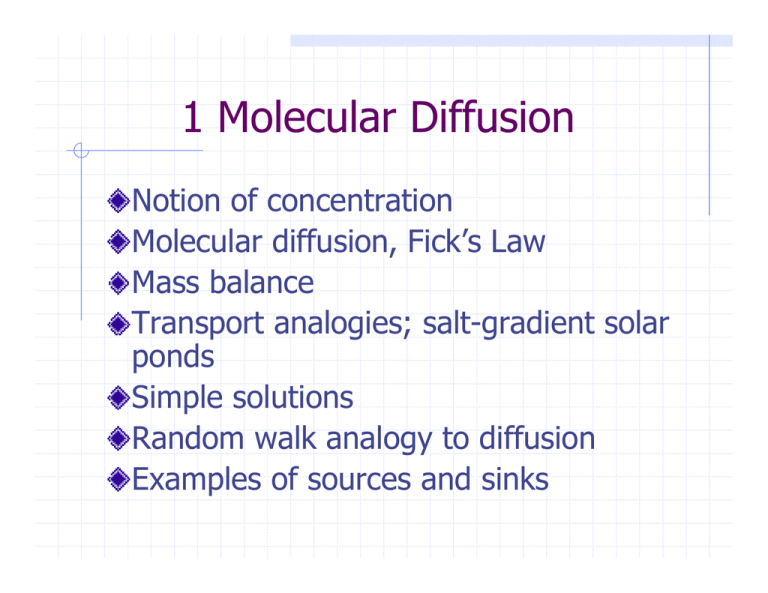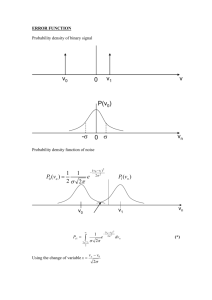1 Molecular Diffusion
advertisement

1 Molecular Diffusion Notion of concentration Molecular diffusion, Fick’s Law Mass balance Transport analogies; salt-gradient solar ponds Simple solutions Random walk analogy to diffusion Examples of sources and sinks Motivation Molecular diffusion is often negligible in environmental problems Exceptions: near interfaces, boundaries Responsible for removing gradients at smallest scales Analytical framework for turbulent and dispersive transport Concentration Contaminant => mixture Carrier fluid (B) and contaminant/tracer (A) If dissolved, then solvent and solute If suspended, then continuous and dispersed phase Concentration (c or ρA) commonly based on mass/volume (e.g. mg/l); also mol/vol (chemical reactions) Mass fraction (salinity): ρA/ρ Note: 1 mg/l ~ 1 mg/kg (water) = 1ppm Molecular Diffusion One-way flux (M/L2-T) z = ρ A wA (2) Net flux = wA ( ρ A1 − ρ A 2 ) lm (1) wA c or ρΑ = − wAl m ∂ρ A / ∂z DAB r J A = − DAB ∇ρ A Ficks Law and Diffusivities r J A = − DAB ∇ρ A r r ∂ r ∂ ∂ ∇( ) = ( ) i + () j+ ()k ∂x ∂y ∂z DAB is isotropic and essentially uniform (temperature dependent), but depends on A, B Table 1.1 summarizes some values of DAB Roughly: Dair ~ 10-1 cm2/s; Dwater ~ 10-5 cm2/s Diffusivities, cont’d Diffusivities often expressed through Schmidt no. Sc = ν/D Roughly: νair ~ 10-1 cm2/s; νwater ~ 10-2 cm2/s Scair ~ 1 Scwater ~ 103 Also: Prandlt no. Pr = ν/κ (κ = thermal cond.) Add advection; total flux of A is: r r N A = ρ A q − DAB ∇ρ A macroscopic velocity vector Conservation of Mass z Like a bank account except expressed as rates: ∆z (NA)x ∆y ∆x y (rate of) change in account = (rate of) (inflow – out) +/(NA)x+∆x (rate of) prod/consumption x Example for x-direction in = ( N A ) x ∆y∆z ⎡ ⎛ ∂N ⎞ ⎤ out = ( N A ) x + ∆x ∆y∆z = ⎢( N A ) x + ⎜ A ⎟∆x ⎥ ∆y∆z ⎝ ∂x ⎠ ⎦ ⎣ ⎡ ⎛ ∂N ⎞ ⎤ net in = ⎢− ⎜ A ⎟∆x ⎥ ∆y∆z ⎣ ⎝ ∂x ⎠ ⎦ Conservation of Mass, cont’d z Account balance = ρ A ∆x∆y∆z Rate of change of account balance x y ∂ = ( ρ A )∆x∆y∆z ∂t Rate of production = rA ∆x∆y∆z Conservation of Mass, cont’d z Sum all terms (incl. advection in 3D) x y ∂ρ A ∂ ∂ ∂ + (N A )x + (N A ) y + (N A )z ∂t ∂x ∂y ∂z r ∂ρ A + ∇ ⋅ N A = rA ∂t Flux divergence (dot product of two vectors is scalar) For carrier fluid B r ∂ρ B ∂t + ∇ ⋅ N B = rB Conservation of Mass, mixture rA = − rB r r r N A + N B = ρq r ∂ρ + ∇ ⋅ ( ρq ) = 0 ∂t ∂ρ ≅ ∇ρ ≅ 0 ∂t r ∇⋅q = 0 Conservation of total mass ρA +ρB =ρ Liquids are nearly incompressible Divergence = 0; Continuity Conservation of Mass, contaminant ρA = c drop subscript A r ∂c + ∇ ⋅ (cq ) = ∇ ⋅ ( D∇c) + r Conservative form of mass cons. ∂t r r ∂c + c∇ ⋅ q + q ⋅ ∇c = D∇ 2 c + (∇D)(∇c) + r ∂t 0 0 ∂c r N.C. form + q ⋅ ∇c = D∇ 2 c∇ + r ∂t r ∂c 2 = D∇ c∇ If q = r = 0 => Ficks Law of Diffusion ∂t Heuristic interpretation of Advection and diffusion c t-1 U t u∆t Advection Flux ~ negative gradient ∆c x c Diffusion t Difference in fluxes (divergence) ~ curvature t-1 J J x Analogs ∂c Ficks Law (mass transfer) = D∇ 2 c ∂t ∂T Fourier’s Law (heat transfer) = κ∇ 2T ∂t r r r rm ∂q r 2r + ( q ⋅ ∇ ) q = υ∇ q + Newton’s Law (mom. Transfer) ρ ∂t ν/D Sc Air ~1 Water ~103 ν/κ Pr ~0.7 ~8 D~κ∼ν D<<κ<ν Example: Salt Gradient Solar Ponds (WE 1-1) like El Paso Solar Pond UCZ GZ ~3m S T dense brine BCZ Solar Pond, diffusive salt flux to UCZ S = 50 o Area = 10,000 m2 oo Z1=0.3m Z2=1.8m UCZ GZ S c = ρS S = 250 o T BCZ oo cUCZ = (1033 Kg/m3)(50x10-3 Kg/Kg) = 52 Kg/m3 cBCZ = (1165 Kg/m3)(250x10-3 Kg/Kg) = 291 Kg/m3 J s = Ddc / dz =(2x10-9)(239 Kg/m3)/1.2m = 4.0x10-7 Kg/m2-s = 344 Kg/day Solar Pond: diffusive thermal flux to UCZ T1 = z1 z2 30oC T φs(z) = φsn(1-β)e-ηz T2 = 80oC d 2T 0 = ρC pκ 2 + η (1 − β )φ sn e −ηz dz −φ * T = 2 e −ηz + c1 z + c 2 η φsn = 250 W/m2 β= fraction of φsn absorbed at surface η = extinction coefficient Cp = heat capacity (4180 J/KgoC); κ = thermal diffusivity (1.5x10-7 m2/s) φ * = η (1 − β )φ sn / ρC pκ c1, c2 from T=T1 at z1, T=T2 at z2 Solar Pond: thermal flux T1 = z1 z2 30oC φsn = 250 W/m2 T φs(z) = φsn(1-β)e-ηz T2 = 80oC J t = ρC pκ (dT / dz ) z = z2 ⎡ −ηz2 (e −ηz2 − e −ηz1 ) ⎤ T2 − T1 = ρC pκ + (1 − β )φsn ⎢e + ⎥ − z 2 − z1 η ( z z ) 2 1 ⎣ ⎦ z1 = 0.3m; z2 = 1.5m, β=0.5, η = 0.6 => Jt = 7 W/m2 Compare with (1-0.5)(250)exp(-0.6*1.5) = 51 W/m2 reaching BCZ (~13% lost) Rankine Cycle Heat Engine Evaporator Brine Turbine generator G Feed pump Cooling water Condenser Figure by MIT OCW. Solar Pond: total energy extraction T1 = z1 z2 φsn = 250 W/m2 30oC T φs(z) = φsn(1-β)e-ηz T2 = 80oC Energy Flux at surface % of φsn 250 W/m2 100 Energy Flux reaching BCZ 51 20 Energy Flux extracted 34 14 Electricity extracted (theoretical) 4.8 2 Electricity extracted (net actual) 2.4 1 Carnot efficiency ηc = (T2-T1)/(T2+273) [24 KWe for 1 ha] Simple Solutions Inst. injection of mass M A x ∂c ∂ c =D 2 ∂t ∂x bc : c = 0 at x = ±∞ M ic : c = δ ( x) at t = 0 + alternative A M r = δ ( x)δ (t ) with c = 0 at t = 0 A 2 Simple Solutions, cont’d Inst. injection of mass M A x Solution by similarity transform (Crank, 1975) or inspection c= B t 1/ 2 e x2 − 4 Dt ∞ A ∫ cdx = M −∞ M = 2 AB πD c ( x, t ) = M e x2 − 4 Dt 2 A πDt Add a current ( x −ut )2 − M 4 Dt c ( x, t ) = e 2 A πDt Gaussian Solution c t x σx x Spatial Moments interpretation ∞ mo = ∫ c( x, t )dx −∞ ∞ m1 = ∫ cxdx M = mo A m1 xc = = ut mo −∞ Center of mass 2 ∞ m2 = ∫ cx dx 2 −∞ Mass; indep of t σx 2 m2 ⎛ m1 ⎞ = − ⎜⎜ ⎟⎟ = 2 Dt mo ⎝ m2 ⎠ Plume variance Spatial Moments, cont’d Relationship of moments to equation parameters ∞ m2 = ∫ 2A −∞ M πDt e − x2 4 Dt x 2 dt M = 2 Dt A m2 2 MDt / A 2 σx = = = 2 Dt mo M/A Without current, odd moments are 0 Spatial Moments, cont’d Rewrite in terms of σ c ( x, t ) = = M 2 A πDt e x2 − 4 Dt M e A 2π σ x − or in 3-D (isotropic) M c ( x, t ) = e 3/ 2 8(πDt ) x2 2σ 2 Plume dilutes by spreading: In 1-D, c ~ t-1/2 ~ σx-1 In 3-D, c ~ t-3/2 ~ σ-3 ( x2 + y2 + z 2 ) − 4 Dt − M = e 3/ 2 3 (2π ) σ ( x2 + y 2 + z 2 ) 2σ 2 Moment generating equation ∂c ∂ c =D 2 ∂t ∂x 2 ∞ mi = i x ∫ cdx −∞ Approach 1: moments of c(x,t) => σ2 = m2/mo = 2Dt Approach 2: moments of ge => moment generation eq. ∞ i x ∫ (each term) dx −∞ Moment generating eq., cont’d ∞ ∂c ∂ c =D 2 ∂t ∂x 2 ∞ 0th moment moment i x ∫ cdx −∞ ∞ dmo ∂c ∂ dx c dx = = ∫ ∂t ∂t −∫∞ dt −∞ ∞ ∞ ∂ 2c ⎛ ∂c ⎞ dx D D = ⎜ ⎟ =0 ∫−∞ ∂x 2 ⎝ ∂x ⎠ −∞ 0 ∞ 2nd mi = ∞ dm2 ∂ ∂c 2 dx x c dx x = = ∫ ∂t ∂t −∫∞ dt −∞ 2 ∞ ∞ ∞ ∞ 2 ∂c 2 ⎛ ∂c ⎞ 2 ∂ c 2 dx = −2 xD(c) ∞−∞ + 2 ∫ Dcdx = 2 Dmo − xD dx Dx Dx = ⎟ ⎜ ∫−∞ ∂x 2 ∫ ∂x ⎝ ∂x ⎠ −∞ −∞ −∞ 0 0 Moment generating eq., cont’d ∂c ∂ c =D 2 ∂t ∂x 2 0th moment 2nd moment dmo =0 dt ∞ mi = i x ∫ cdx −∞ => mo = const = M/A dm2 = 2 Dmo dt => dσ2/dt = 2D or σ2 = 2Dt dσ 2 mo = 2 Dmo dt How fast is molecular diffusion? Creating linear salinity distribution from initial step profile z Assume 80 cm tank; 40 2cm steps S Time to diffuse: σ2 Table 1-1 = 2Dt t = σ2/2D ~(2cm)2/(2)(1.3x10-5 cm2/s) = 1.5x105s ~ 2 days slow! If thermal diffusion (100 x faster), t < 1 hr Spatially distributed sources c co t ∂ 2c ∂c 0 =D 2 ∂x ∂t bc c = 0 at x = ∞ c = co at x = −∞ ic c = co c=0 x or c = co/2 at x = 0 for x < 0 at t = 0 for x > 0 at t = 0 Spatially distributed sources co ξ dξ x 0 dc(ξ , t ) = ∞ c ( x, t ) = ∫ x dM 2 A πDt c o dξ 2 πDt e e − −ξ 2 4 Dt ξ2 4 Dt = co = 2 c o dξ 2 πDt e − x ξ2 4 Dt ⎡ ⎛ x ⎞⎤ co ⎛ x ⎞ ⎟⎟⎥ = erfc⎜⎜ ⎟⎟ ⎢1 − erf ⎜⎜ ⎝ 2 Dt ⎠⎦ 2 ⎝ 2 Dt ⎠ ⎣ Error Function 2 π e −α 2 erf(ω) erfc(ω) ω erf (ω ) = erfc(ω ) = 2 π 2 ω ∫e −α 2 dα erf (∞) = 1 0 ∞ e ∫ π ω erf (0) = 0 −α 2 dα erfc( x) = 1 − erf ( x) α Example: DO in Fish aquarium (WE 1-4) 2(c2-c1) C1 C2 t=0: c=c1=8 mg/l (csat at 27oC) 2C2 – C1 c t t>0: c(0)=c2=10 mg/l (csat at 16oC) ( 1 c( z ,t ) = c1 + 2(c 2 − c1 ) erfc z / 2 Dt 2 ( c − c1 = erfc z / 2 Dt c 2 − c1 z ) ) Evaluate at z =15 cm, D = 2x10-5 cm2/s (Table 1-1) t 1hr z/(4Dt)0.5 erfc[(z/(4Dt)0.5] 28 0 1d 5.7 10-15 1 mo 1.0 0.15 Again, very slow! Diffusion as correlated movements t x=0 at t=0 x (t ) = ∫ u ( t ' ) dt ' 0 p(x,t) x Analogy between p(x) and c(x); ergotic assumption For many particles, both distributions become Normal (Gaussian) through Central Limit Theorem Statistics of velocity u =0 mean velocity u 2 = const. variance u (t )u (t − τ ) = u (0)u (τ ) = u (−τ )u (0) auto co-variance u (t )u (t − τ ) u (t ) 2 = R(τ ) auto correlation R(τ) 1 0 τ Statistics of position t x(t ) = ∫ u (t ' )dt ' 0 t t 0 0 x = ∫ u (t ' )dt ' = ∫ u (t )dt = 0 x 2 (t ) increases with time, as follows t ⎡t ⎤ dx 2 (t ) dx = 2 x(t ) = 2 ⎢ ∫ u (t ' )dt '⎥u (t ) = 2 ∫ u (t )u (t ' )dt ' dt dt 0 ⎣0 ⎦ t t d x 2 (t ) = 2u 2 (t ) ∫ R (t − t ' )dt ' = 2u 2 (t ) ∫ R (τ )dτ dt 0 0 d x 2 dσ 2 D= = = u 2 ∫ R(τ )dτ Taylor’s Theorem (1921); classic 2dt 2dt 0 t [D] = [V2T] Earlier, D = wAl m [VL] or D= σ2 2t [L2/T] Random Walk (WE 1-3) Special case: u (t ) = U or − U direction changes randomly after ∆t Walker’s position at time t=N∆t Probability distribution N x = ∑ u∆t 1 p (χ , N ) = 0.5 N! ⎛ 1 ⎞ ⎜ N⎟ + N χ N − χ ⎛ ⎞ ⎛ ⎞ ⎝2 ⎠ ⎜ ⎟ ⎜ ⎟ ⎝ 2 ⎠ ⎝ 2 ⎠ ! ! 3/8 0.375 Bernoulli Distribution 2/8 Approaches Gaussian for large N 0.25 1/8 0.125 0 -3 -3 χ = x/Ut 1 -1 1 -1 3 3 Example for N=3 Statistics of position N x (t ) = ∑ u ( t ) = 0 i =1 2 ⎛ ⎞ σ 2 = ⎜ ∑ u∆t ⎟ = ∆t 2 [(u 1 + u 2 K u i + K u N )(u 1 + u 2 + K u N )] ⎝ i =1 ⎠ = N∆t 2U 2 = tU 2 ∆t = t∆x 2 / ∆t N σ2 U 2 ∆t ∆x 2 D= = = 2t 2 2∆t [L2/T ] Alternatively, derive D from Taylor’s Theorem Examples of Sources and Sinks (r terms) 1st order 0th order 2nd order Coupled reactions Mixed order 1st Order c/co Example: radioactive decay dc = − kc dt c / co = e − kt 1 0.5 0.37 0.1 0 t1/2 k-1 t90 Half life e-folding time Linearity => 1st O decay multiplies simple sol’n by e-kt; e.g. Also very convenient in particle tracking models t 0th Order S/So Example: silica uptake by diatoms (high diatom 1 conc) dS = −B dt S = S o − Bt 0 S=substrate (silica) concentration B=rate (depends on diatom population, but assume large) So/B t 2nd Order Example: particleparticle collisions/reactions; flocculant settling) dc = − Bc 2 dt 1 c = co 1 + Btco c/co 1 0 co Behavior depends on co; slower than e-kt. Can be confused with multiple species undergoing 1st order removal t Coupled Reactions Example: Nitrogen oxidation dN1 = − K12 N1 dt dN 2 = K12 N1 − K 23 N 2 dt dN 3 = K 23 N 2 dt N1 = NH3-N N2 = NO2-N N3 = NO3-N If N’s are measured as molar quantities, or atomic mass, then successive K’s are equal and opposite Mixed Order—Saturation Kinetics (Menod kinetics) Example: algal uptake of nutrients—focus on algae rmax dc kS = dt S + S o Rmax/2 c = algal concentration S = substrate concentration So = half-saturation const S << So => S >> So => r So dc kS ≅ = k'S dt S o (1st Order) dc ≅k dt (0th Order) S 1 Wrap-up Molecular diffusivities Molecular motion; Eulerian frame D = wl m dσ D= 2 2dt 2 Method of moments ∞ D = u 2 ∫ R (τ )dτ Molecular motion; Lagrangian frame 0 D is “small” ~ 1x10-5 cm2/s for water Inst. point source solutions are Gaussian; other solutions built from Spatial and temporal integration, coordinate translation, linear source/sink terms




